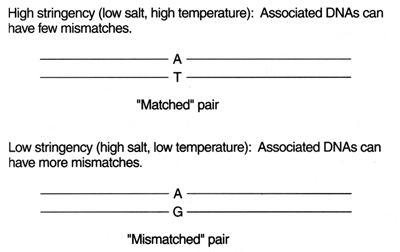Nucleic acid hybridization allows scientists to compare and analyze DNA and RNA molecules of identical or related sequences. In a hybridization experiment, the experimenter allows DNA or RNA strands to form Watson-Crick base pairs. Sequences that are closely related form base-paired double helices readily; they are said to be complementary. The amount of sequence complementarity is a measure of how closely the information of two nucleic acids relate. The complementary strands can be both DNAs, both RNAs, or one of each.
Heating the DNA solution above a characteristic temperature can separate the two strands of a double helix. That temperature is called the melting temperature, abbreviated Tm . Above the Tm, a DNA is mostly or all single-stranded; below the Tm, it is mostly double-stranded. For a natural DNA, the Tm depends primarily on its G+C content. Because a G–C base pair has three hydrogen bonds and an A–T pair only has two, nucleic acid double helices with a high G+C content have a higher Tm than do those with a greater proportion of A+T. The Tm is not an exact property: It depends on the solvent conditions. For example, a high concentration of salt (such as NaCl) raises the Tm of a DNA duplex, because the positive Na+ ions shield the negative charges on the phosphodiester backbone from repelling each other. Likewise, certain organic solvents can cause the negative charges on the phosphates to repel more strongly; these solvents lower the Tm of a DNA double helix.
What happens if two nucleic acids are partly complementary and partly different? In this case, some stretches of the two strands may form base pairs while others don't. The two molecules can be manipulated so that they form a hybrid or separate. The conditions favoring the formation of duplex nucleic acid are low temperature (below the Tm), high salt, and the absence of organic solvents. The latter two conditions raise the Tm of the hybrid duplex so that the DNA would remain more double-stranded. On the other hand, higher temperatures (closer to the Tm of the hybrid) lower salt, and the presence of organic solvents would tend to push the two strands of the DNA apart. The term stringency sums up these variables: The more stringent the conditions, the more likely partially complementary sequences are to be forced apart. Conversely, less stringent hybridization conditions mean that the two strands need not be so complementary to form a stable helix. See Figure 1 .
| |||
| |||
Hybridization can be used to classify the DNAs of various organisms. For example, human DNA is 98 percent identical to that of chimpanzees, and these two DNAs form a duplex under stringent conditions. Related sequences of humans and birds can also form hybrids, but only at a much lower stringency.

0 comments:
Post a Comment